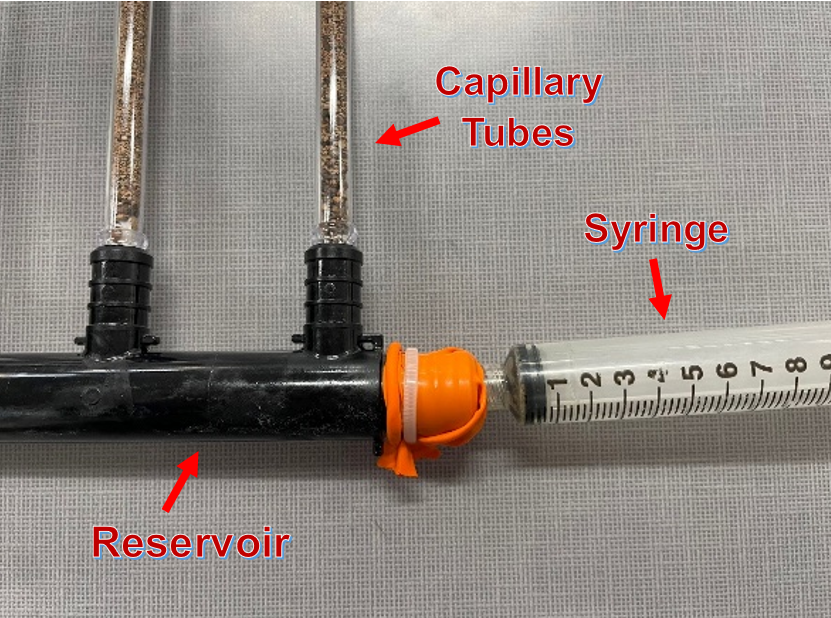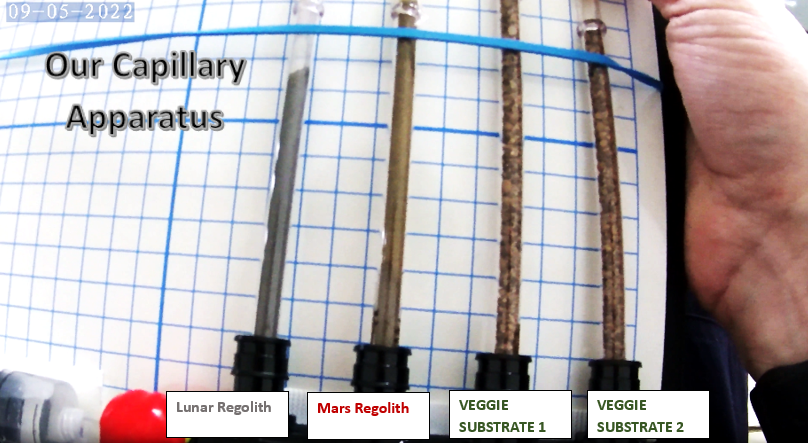Educator Onboarding
LEO Art Challenge Workshop
ICE 2019: Satellite Tracking, Orbits, and Modeling
SEEC 2019: Satellite Tracking, Orbits, and Modeling
Workshop:ITEC Trek-a-Sat
Workshop: 2018-01-27 Yerkes
Workshop: 2017-10-28 Carthage-Yerkes Electrostatics in Space
Workshop: 2017-06-29-BTCI-Life in Space!
Workshop: 2017-03-11 Yerkes
Workshop: 2017-02-07 SEEC
Workshop: 2017-01-28 Yerkes
Tools You Might Use
Educational Learning
Standards
Documentation
Water Movement in Different Simulants Part 1
Topic outline
-
Author: Laura Tomlin, Salado Middle School, Salado, TX
Assisted by: Natalie Orrantia, Univ of Chicago Updated: August, 2023
Summary
This is the first in a series of experiments comparing water movement in Lunar regolith simulant, Mars regolith simulant and ISS-VEGGIE growth substrate inside and outside of microgravity environments. Students learn to understand the effects of these environments on capillary action, or upwards water movement, as well as the mechanics of force and motion and the influence of gravity on water diffusion. Ms. Tomlin had the opportunity to test these student experiments in different microgravity environments aboard a 0-g flight. This project allows students to investigate regolith behavior on Earth, as well as consider its behavior off world.
See Continuation Water Movement in Different Lunar Regolith Simulants Part 2: https://spacedge.nss.org/course/view.php?id=293#section-1
Age of Students: 11+ yearsProject Goals:
To compare water uptake in Mars and lunar regolith simulants, and the VEGGIE growth substrate used on board the International Space Station.
To determine or consider the effect of reduced gravity and microgravity on movement of water in the above substrates.
- To provide an authentic learning experience for students which deepen understanding of force and motion, space research, capillary action, engineering design process, and scientific inquiry.
Keywords/Topics Covered:
Capillary Action, Gravity, Forces, Regolith, Microgravity, Space Exploration, Soil Chemistry, Newton’s Laws, Soil Texture, Water Diffusion

Image Credits to GIFGIFs Services
US Next Generation Science Standards (NGSS) Connections:
Properties of Matter PS1.A
Force and Motion PS2.A, PS2.B
Space Systems ESS1.A, ESS1.B
History of the Earth, Earth’s Systems ESS2.A, ESS2.C, ESS3.A
Engineering Design ETS1.A, ETS1.B, ETS1.C
Required prerequisites / prior knowledge:
Engineering design process
Experimental process
Forces and Motion: Newton’s Laws, balanced and unbalanced forces, gravity, microgravity, capillary force, adhesion, cohesion
Space Science- Space Research
Regolith and regolith simulants
Subsequent Project: Water Movement in Different (Lunar) Regolith Simulants (Part 2) -
1. PhETGravity Force Lab (Simulation)
This PhET interactive simulation provided by the University of Colorado explores the effects of mass and forces between objects. Use the links below to help students conduct their own force experiments.

https://phet.colorado.edu/en/simulations/gravity-force-lab-basics
https://phet.colorado.edu/en/simulations/gravity-force-lab
This short real-world simulation created for national astronauts day, allows students to experiment with concepts of free fall and microgravity in a hands-on, student led project.
https://docs.google.com/document/d/14RThOj_gj2EjRZqu17FIrDwBtXqZufnDzp0Hqr9ab3s/edit
-
Background of Lesson:
Students had the unique opportunity through Wisconsin Space Grant’s Embedded Teacher Program to design and test experiments and equipment for flight aboard the Zero-G parabolic plane in May 2022. One of several experiments conducted compared the rate of water movement through lunar regolith simulant, Mars regolith simulant, and the ISS-VEGGIE growth substrate.
This experiment was conducted by students in the classroom at 1-G. Students reviewed balanced and unbalanced forces, Newton’s Laws of Motion, capillary action, adhesion and cohesion, and the effect of soil texture on water movement. Students then made predictions on how data would change in a reduced gravity and zero gravity environment. Classroom data was compard to data collected by Laura Tomin in 0-G, lunar-G, and Mars-G environments aboard the Zero-G airplane.
This experiment was modified and flown on a subsequent flight in November, 2022.
Students would benefit from watching the following videos containing important background knowledge!
Porosity: What is it? How does it work?
Regolith vs. Soil: What is a regolith?Materials Needed:
For building our apparatus and our procedure:
Four 15-cm capillary tubes
Reservoir (where tubes will be connected) *source image*
Latex
Zip ties
Tape
5-cm 3/16’’ nylon tube

Velcro (two or more pieces)
Syringe (common syringe)
Grid board Image Credits to GIFGIFs Services
Coffee Filter
Rubber bands
Lunar regolith, Mars regolith, and VEGGIE substrate simulants
Timer (phones may be used)

Building the apparatus:
The capillary apparatus constructed by students in here part 1, is reused in part 2; ensure accurate construction for continuation!
Seal reservoir with latex; zip tie and tape to secure.
Poke a small hole in latex, and then insert a 5 cm 3/16” nylon tube into the hole
Insert syringe containing 20 ml water into a nylon tube
Velcro reservoir with the syringe attached to the bottom of a 1-cm grid board
Place four 15-cm capillary tubes in each reservoir
Place one layer of the coffee filter at bottom of the tube, wrap it with tape
Fill tube to within 1 cm of the top with lunar regolith ( soil simulant)
Repeat with Mars regolith and (2) VEGGIE soils
Insert a small piece of the coffee filter into the top of each tube, holding substrates in place
Experimental Procedures
1. Attach the syringe and capillary apparatus to grid board, make sure to hold tubes in place with a large rubber band
2. Set a timer (possibly a phone) to 15 seconds
3. Begin recording your video
4. Countdown and on “Go” inject water into tube, counting to 5 as injecting
5. Continue filming, announce at 20, 60, 90, and 120 seconds.
6. Stop the recording!
7. Review your video, and record water uptake seen (darkened soil) for each soil type at each interval listed above
-
Use the Following Data Sheet to Record your Results; printable version is attached!

 Image Credits to GIFGIFs Services
Image Credits to GIFGIFs ServicesQuestions / Conclusions (To be done with whole class or addressed in groups):
Which substrate had the greatest movement of water?
Why do you believe the water moves more easily?
Which substrate had the least water movement?
Why do you believe the water did NOT move as easily?
Explain Capillary action in your own words:
(Explain) How do you think water movement would change in lunar gravity?
(Explain) How do you think water movement would change in Mars gravity?
(Explain) How do you think water movement would change in microgravity?
Why is it important to understand how water moves through soil?
Explain why understanding water movement in Mars and lunar regolith is important to space science.
How could this experiment be improved?
What additional question(s) should be investigated based on these results?
-
This experiment was modified and taken on board a Zero-G parabolic plane, using the same capillary structure and techniques students employed in class, the experiment was repeated!
The video results of this experiment is seen below:
Initial Image:

Take a minute to watch this short clip taken during the flight!
Now look at our final positions and complete your collection of data
Final Image:

With your class, watch the results video and images of this experiment in lunar and microgravity environments and record data and observations:
Once data has been collected, work in groups or individually to write a conclusion:
When writing your conclusion, include your explanation for each of the following points in one or more sentences:Summary of the rate of water movement changes in lunar-g, Mars-g, and zero-g environments.
Explain the results, try using Newton’s second law of motion and other factors affecting capillary uptake.
Discuss the possible problems encountered during flight, and their solutions, keep all problems and solutions reasonable.
Write your ideas for modifications of designs and/or future experiments.
Explain the importance of this experiment in both space and Earth science.
-
Video: Regolith simulants
https://twitter.com/seeker/status/1597266568575995904?s=51&t=9Q7kSjT8fhHY2Ys4mRNfjw
Surface Tension Paperclip and Boat activity
https://www.teachengineering.org/activities/view/cub_earth_lesson2_activity4
Astronaut in a bottle:
https://www.dreamup.org/astronaut-in-a-bottle/
Walking water experiment: refer to PDF file attached!
https://docs.google.com/document/d/13MhpJ2A6jNgqh2qXkqfD2Qy91q0UbIPkSYRKq5HF2EM/edit
Break the Tension: refer to PDF file attached!
https://docs.google.com/document/d/1-tPWeiAyI3pZuOXiOk5y-uIGRTyjer6VzdWAJCUZpKU/edit?usp=sharing
Astronaut in a Bottle: refer to PDF file attached!
https://docs.google.com/document/d/14RThOj_gj2EjRZqu17FIrDwBtXqZufnDzp0Hqr9ab3s/edit?usp=sharing
PhETGravity Force Lab (Simulation)
https://phet.colorado.edu/en/simulations/gravity-force-lab-basics
https://phet.colorado.edu/en/simulations/gravity-force-lab
NASA Technical Reports (search by topic)
-
Send a Postcard to Space through NSS Supported Blue Origin Club For The Future initiative!
Visit: SpacEdge Academy Postcards in Space Course

